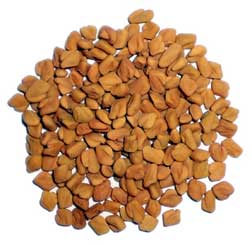|
| |
Indian
herbs: Fenugreek ( Methi )
Main
Article page |
Beauty articles
|
Health page |
Computers|
Diseases |
Education |
Entertainment |
Family
Business |Fitness|
Fruits and Vegetables
|
Jobs |
General |
Personality|
Technology
|
Tourism |
Useful Tips
Biography Page|
Heroes & Incredible peoples
|
Inventions

Hindi: Meti, Mutti; Ben,
Sanscrit: Methika, Methi, Kalanusari; Marathi: Methi; Malayalam: Uluva;
Tamil : Ventayam; Kannnada: Mentya, Menlesoppu; Telugu: Mentulu,
Mentikura; Arab: Hulabaha
Fenugreek (also known
as Greek Hay and Fenigreek), is an herb that is commonly found growing in the
Mediterranean region of the world. While the seeds and leaves are primarily used
as a culinary spice, it is also used to treat a variety of health problems in
Egypt, Greece, Italy, and South Asia. Fenugreek is used both as a herb (the
leaves) and as a spice (the seed, often called methi).
Fenugreek seeds have been found to contain protein, vitamin C, niacin,
potassium, and diosgenin (which is a compound that has properties similar to
estrogen). Other active constituents in fenugreek are alkaloids, lysine and L-tryptophan,
as well as steroidal saponins (diosgenin, yamogenin, tigogenin, and neotigogenin).
Importance
Fenugreek or Greek Hayes is
cultivated as a leafy vegetable, condiment and as medicinal plant. The leaves
are refrigerant and aperient and are given internally for vitiated conditions of
pitta. A poultice of the leaves is applied for swellings and burns. Seeds are
used for fever, vomiting, anorexia, cough, bronchitis and colonitis. In the
famous Malayalam treatises like ‘Padhyam’ ‘Kairali’ and ‘Arunodhayam’, uluva is
recommended for use as kalanusari in Dhanvantaram formulations of ‘Astaghradayam’.
An infusion of the seeds is a good cool drink for small pox patients. Powdered
seeds find application in veterinary medicine. An aqueous extract of the seeds
possesses antibacterial property (Kumar et al,
Distribution
Fenugreek is a native of South
Eastern Europe and West Asia. In India fenugreek is grown in about 0.30 lakh ha
producing annually about 30,000 tonnes of seeds. The major states growing
fenugreek are Rajasthan, Madhya Pradesh, Gujarat, Uttar Pradesh, Maharashtra,
Punjab and Karnataka. It is grown wild in Kashmir and Punjab.
Botany
Trigonella foenum-graecum
Linn. belongs to family, Fabaceae. It is an annual herb, 30-60cm in height,
leaves are light green, pinnately trifoliate, leaflets toothed, flowers are
white or yellowish white, papilionaceous and axillary. Fruits are legumes,
5-7.5cm long, narrow, curved, tapering with a slender point and containing 10-20
deeply furrowed seeds per pod. There are two species of the genus Trigonella
which are of economic importance viz. T. foenum graecum, the common methi and T.
corniculata, the Kasuri methi. These two differ in their growth habit and yield.
The latter one is a slow growing type and remains in rosette condition during
most of the vegetative growth period
Agrotechnology
Fenugreek has a wide
adaptability and is successfully cultivated both in the tropics as well as
temperate regions. It is tolerant to frost and freezing weather. It does well in
places receiving moderate or low rainfall areas but not in heavy rainfall area.
It can be grown on a wide variety of soils but clayey loam is relatively better.
The optimum soil pH should be 6-7 for its better growth and development. Some of
the improved cultivars available for cultivation are CO1 (TNAU), Rajendra Kanti
(RAU), RMt-1(RAU) and Lam Selection-1 (APAU). Land is prepared by ploughing
thrice and beds of uniform size are prepared. Broadcasting the seed on the bed
and raking the surface to cover the seeds is normally followed. But to
facilitate intercultural operations, line sowing is also advocated in rows at
20-25cm apart. Sowing in the plains is generally in September-November while in
the hills it is from March. The seed rate is 20-25kg/ha and the seeds germinate
within 6-8 days. Besides 15t of FYM, a fertiliser dose of 25:25:50kg NPK/ha is
recommended. Entire P,K and half N are to be applied basally and the remaining
half N 30 days after sowing. First irrigation is to be given immediately after
sowing and subsequent irrigations at 7-10 days interval. Hoeing and weeding are
to be done during the early stages of plant growth and thinning at 25-30 days to
have a spacing of 10-15cm between plants and to retain 1-2 plants per hill. Root
rot (caused by Rhizoctonia solani) is a serious disease and can be controlled by
drenching carbendazim 0.05% first at the onset of the disease and another after
one monthof first application. In about 25-30 days, young shoots are nipped off
5cm above ground level and subsequent cuttings of leaves may be taken after 15
days. It is advisable to take 1-2 cuttings before the crop is allowed for
flowering and fruiting when pods are dried, the plants are pulled out, dried in
the sun and seeds are threshed by beating with stick or by rubbing with hands.
Seeds are winnowed, cleaned and dried in the sun. They may be stored in gunny
bags lined with paper. An yield of 1200-1500kg of seeds and about 800-1000kg of
leaves may be obtained per hectare in crops grown for both the purposes
Properties and Activity
Seeds contain
sapogenins-diosgenin, its 25-epimer(yamogenin), tigogenin, gitogenin, yuccagenin,
25-2-spirosta-3-5-diene and its b-epimer. Seeds also contain a C27-steroidal
sapogenin-peptide ester-fenugreekine. Seeds, in addition, contain
4-hydroxyleucine andsaponins-fenugrins A-E:two furostanol
glycoxides-trigonelloxide C and (255)-22-O-methyl-
52-firostan-3b,22,26,triol-3-O-a-rhamnopyrans syl(1-2) C-b-D-glucopyranosyl
(1-3)-b-Dglucopyranoxide- 26-O-b-D-glucopyranoxide. Other chemical constituents
are sterols-b-sitosterol and cholesterol, flavone Cglycosides- vitexin,
iso-vitexin, vitexin-2”-O-P-coumarate and vicenin-2. Flavonoidsquercetin and
luteolin, flavonoid glycoside-vicenin-I. Invitro seedling callus culture gave
flavonoids-luteolin and vitexin-1-glycoside. An essential oil is also reported
from seeds. Leaves gave saponins-gracecunins A-G, flavonoids- kaempferol and
quercetin; sterols-b- sitosterol, sapogenins-diosgenin, gitogenin
coumarin-scopoletin is also reported from the plant.
Seeds are bitter,
mucilaginous, aromatic, carminative, tonic, diuretic, thermogenic, galactagogue,
astringent, emollient, amophrodisiac, antirheumatic, CNS depressant and
antiimplantation. Fenugreekine is hypoglycaemic, diuretic, hypotensive,
cardiotonic, antiphlogistic. It showed 80% inhibition of vaccina virus.
( Reference :MEDICINAL PLANTS P. P. Joy, J.
Thomas, Samuel Mathew, Baby P. Skaria, Kerala Agricultural University)
| |
|



